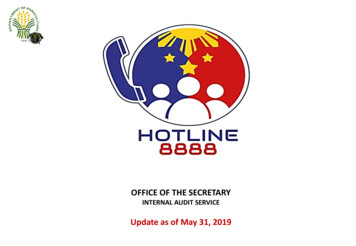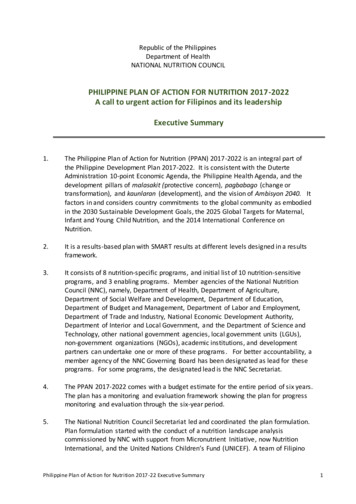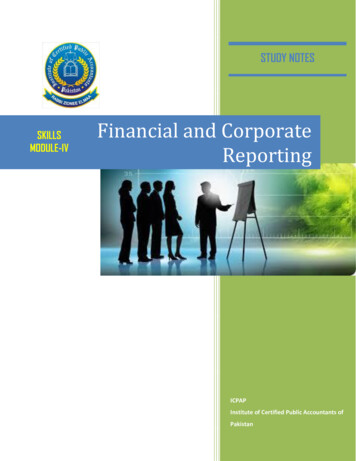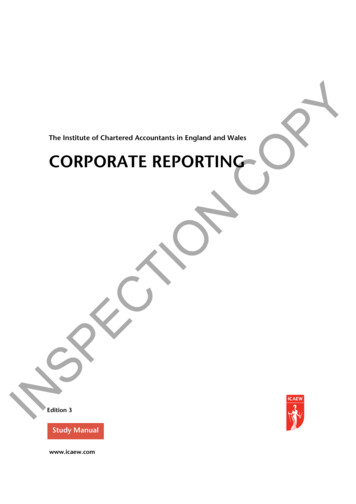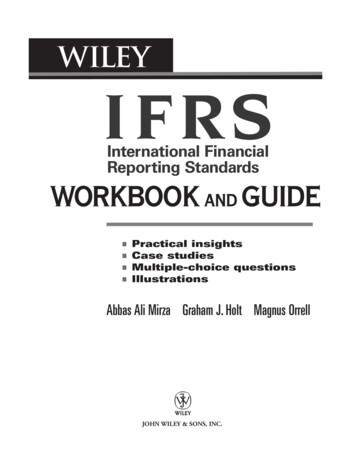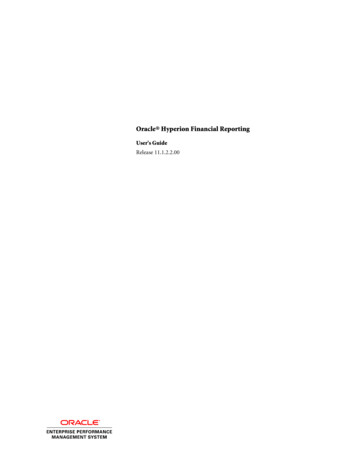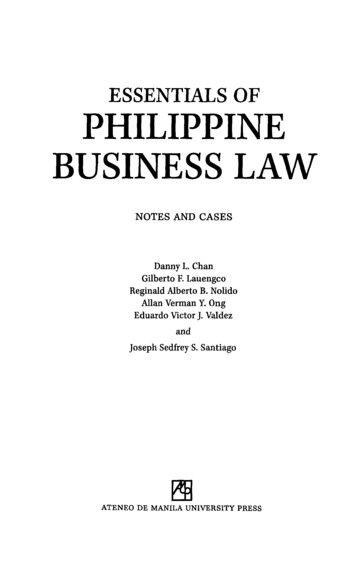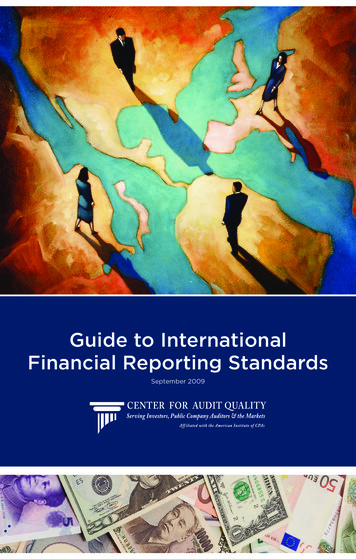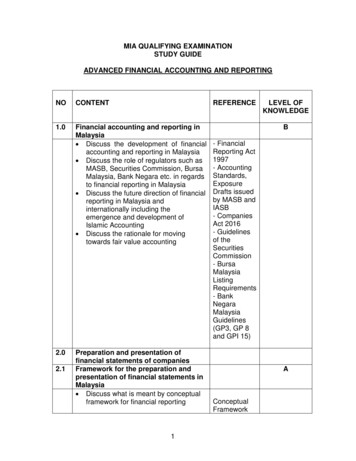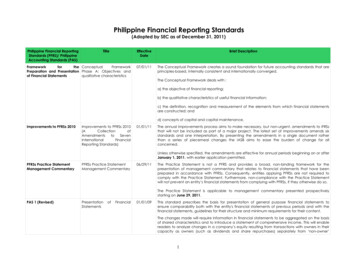
Transcription
Philippine Financial Reporting Standards(Adopted by SEC as of December 31, 2011)Philippine Financial ReportingStandards (PFRS)/ PhilippineAccounting Standards (PAS)TitleFrameworkforthe ConceptualFrameworkPreparation and Presentation Phase A: Objectives andof Financial Statementsqualitative characteristicsEffectiveDateBrief Description07/01/11The Conceptual Framework creates a sound foundation for future accounting standards that areprinciples-based, internally consistent and internationally converged.The Conceptual Framework deals with :a) the objective of financial reporting;b) the qualitative characteristics of useful financial information;c) the definition, recognition and measurement of the elements from which financial statementsare constructed; andd) concepts of capital and capital maintenance.Improvements to PFRSs 2010Improvements to PFRSs nancialReporting Standards)01/01/11The annual improvements process aims to make necessary, but non-urgent, amendments to IFRSsthat will not be included as part of a major project. The latest set of improvements amends sixstandards and one interpretation. By presenting the amendments in a single document ratherthan a series of piecemeal changes the IASB aims to ease the burden of change for allconcerned.Unless otherwise specified, the amendments are effective for annual periods beginning on or afterJanuary 1, 2011, with earlier application permitted.PFRSs Practice StatementManagement CommentaryPFRSs Practice StatementManagement Commentary06/29/11The Practice Statement is not a PFRS and provides a broad, non-binding framework for thepresentation of management commentary that relates to financial statements that have beenprepared in accordance with PFRSs. Consequently, entities applying PFRSs are not required tocomply with the Practice Statement. Furthermore, non-compliance with the Practice Statementwill not prevent an entity’s financial statements from complying with PFRSs, if they otherwise do so.The Practice Statement is applicable to management commentary presented prospectivelystarting on June 29, 2011.PAS 1 This standard prescribes the basis for presentation of general purpose financial statements toensure comparability both with the entity's financial statements of previous periods and with thefinancial statements, guidelines for their structure and minimum requirements for their content.The changes made will require information in financial statements to be aggregated on the basisof shared characteristics and to introduce a statement of comprehensive income. This will enablereaders to analyze changes in a company’s equity resulting from transactions with owners in theircapacity as owners (such as dividends and share repurchases) separately from ‘non-owner’1
Philippine Financial ReportingStandards (PFRS)/ PhilippineAccounting Standards (PAS)TitleEffectiveDateBrief Descriptionchanges (such as transactions with third parties).The revised standard gives preparers of financial statements the option of presenting items ofincome and expense and components of other comprehensive income either in a singlestatement of comprehensive income with subtotals, or in two separate statements (a separateincome statement followed by a statement of comprehensive income).The revisions include changes in the titles of some of the financial statements to reflecttheirfunction more clearly (for example, the balance sheet is renamed a statement of financialposition). The new titles will be used in accounting standards, but are not mandatory for use infinancial statements.The revised standard introduces a requirement to present a statement of financial position at thebeginning of the earliest comparative period in a complete set of financial statements when theentity applies an accounting policy retrospectively or makes a retrospective restatement, asdefined in PAS 8, Accounting Policies, Changes in Accounting Estimates and Errors, or when theentity reclassifies items in the financial statements.Amendment to PASCapital Disclosures1:01/01/07The Amendments to PAS 1 adds requirements for all entities to disclose the entity’s objectives,policies and processes for managing capital; quantitative data about what the entity regards ascapital; whether the entity has complied with any capital requirements; and if it has not complied,the consequences of such non-compliance.These disclosures provide information about the level of an entity’s capital and how it managescapital, which are important factors for users to consider in assessing the risk profile of an entityand its ability to withstand unexpected adverse events.Amendments to PAS 32 andPAS 1: Puttable FinancialInstruments and ObligationsArising on Liquidation01/01/09This Standard requires a financial instrument to be classified as a liability if the holder of thatinstrument can require the issuer to redeem it for cash. This principle works well in most situations.However, many financial instruments that would usually be considered equity, including someordinary or common shares and partnership interests, allow the holder to ‘put’ the instrument (torequire the issuer to redeem it for cash). Currently these financial instruments are consideredliabilities, rather than equity.The amendments to PAS 32 address this issue and provide that puttable financial instruments willbe presented as equity only if all of the following criteria are met:a. the holder is entitled to a pro-rata share of the entity’s net assets on liquidation;b. the instrument is in the class of instruments that is the most subordinate and all instrumentsin that class have identical features;c. the instrument has no other characteristics that would meet the definition of a financialliability; andd. the total expected cash flows attributable to the instrument over its life are basedsubstantially on the profit or loss, the change in the recognized net assets or the changein the fair value of the recognized and unrecognized net assets of the entity (excluding2
Philippine Financial ReportingStandards (PFRS)/ PhilippineAccounting Standards (PAS)TitleEffectiveDateBrief Descriptionany effects of the instrument itself). Profit or loss or change in recognized net assets for thispurpose is as measured in accordance with relevant IFRSs.In addition to the criteria set out above, the entity must have no other instrument that has termsequivalent to (d) above and that has the effect of substantially restricting or fixing the residualreturn to the holders of the puttable financial instruments.Additional disclosures are required about the instruments affected by the amendments.The amendments will apply for annual periods beginning on or after January 1, 2009, with earlierapplication permitted. If an entity applies these amendments for a period beginning beforeJanuary 1, 2009 it shall disclose that fact and apply the related amendments to PAS 39, FinancialInstruments: Recognition and Measurement, PFRS 7 Financial Instruments: Disclosures, andPhilippine Interpretation IFRIC–2, Members’ Shares in Co-operative Entities and Similar Instruments,at the same time.Amendments to PAS 1:Presentation of Items ofOtherComprehensiveIncome07/01/12Presentation of Items of Other Comprehensive Income (Amendments to PAS 1) amendedparagraphs 7, 10, 82, 85-87, 90, 91, 94, 100 and 115, added paragraphs IN17-IN19, 10A, 81A, 81B,82A and 139J and deleted paragraphs 12, 81, 83 and 84.An entity shall apply those amendments for annual periods beginning on or after July 1, 2012.Earlier application is permitted.PAS 2Inventories01/01/05This Standard prescribes the accounting treatment for inventories. A primary issue in accountingfor inventories is the amount of cost to be recognized as an asset and carried forward until therelated revenues are recognized. This Standard provides guidance on the determination of costand its subsequent recognition as an expense, including any write-down to net realizable value. Italso provides guidance on the cost formulas that are used to assign costs to inventories.PAS 7Statement of Cash Flows01/01/05Information about the cash flows of an entity is useful in providing users of financial statements witha basis to assess the ability of the entity to generate cash and cash equivalents and the needs ofthe entity to utilize those cash flows. The economic decisions that are taken by users require anevaluation of the ability of an entity to generate cash and cash equivalents and the timing andcertainty of their generation.This Standard requires the provision of information about the historical changes in cash and cashequivalents of an entity by means of a statement of cash flows which classifies cash flows duringthe period from operating, investing and financing activities.PAS 8AccountingPolicies,Changes in AccountingEstimates and Errors01/01/05This Standard prescribes the criteria for selecting and changing accounting policies, together withthe accounting treatments and disclosure of changes in accounting policies, changes inaccounting estimates and correction of errors. The Standard is intended to enhance therelevance and reliability of an entity's financial statements, and the comparability of thosefinancial statements over time and with the financial statements over time and with the financialstatements of other entities.3
Philippine Financial ReportingStandards (PFRS)/ PhilippineAccounting Standards (PAS)TitleEffectiveDateBrief DescriptionDisclosure requirements for accounting policies, except those for changes in accounting policies,are set out in PAS 1 Presentation of Financial Statements.PAS 10Events after the BalanceSheet Date01/01/05This Standard prescribes:a) when an entity should adjust its financial statements for events after the balance sheet date;andb) the disclosures that an entity should give about the date when the financial statements wereauthorized for issue and about events after the balance sheet date.The Standard also requires that an entity should not prepare its financial statements on a goingconcern basis if events after the balance sheet date indicate that the going concern assumptionis not appropriate.PAS 11Construction Contracts01/01/05This Standard prescribes the accounting treatment of revenue and costs associated withconstruction contracts. Because of the nature of the activity undertaken in construction contracts,the date at which the contract activity is entered into and the date when the activity iscompleted usually fall into different accounting periods. Therefore, the primary issue in accountingfor construction contracts is the allocation of contract revenue and contract costs to theaccounting periods in which construction work is performed. This Standard uses the recognitioncriteria established in the Framework for the Preparation and Presentation of Financial Statementsto determine when contract revenue and contract costs should be recognized as revenue andexpenses in the income statement. It also provides practical guidance on the application of thesecriteria.PAS 12Income Taxes01/01/05This Standard prescribes the accounting treatment for income taxes. The principal issue inaccounting for income taxes is how to account for the current and future tax consequences of:a) the future recovery (settlement) of the carrying amount of assets (liabilities) that are recognizedin an entity's statement of financial position; andb) transactions and other events of the current period that are recognized in an entity's financialstatements.It is inherent in the recognition of an asset or liability that the reporting entity expects to recover orsettle the carrying amount of that asset or liability. If it is probable that recovery or settlement ofthat carrying amount will make future tax payments larger (smaller) than they would be if suchrecovery or settlement were to have no tax consequences, this Standard requires an entity torecognize a deferred tax liability (deferred tax asset), with certain limited exceptions.This Standard requires an entity to account for the tax consequences or transactions and otherevents in the same way that it accounts for the transactions and other events themselves. Thus, for4
Philippine Financial ReportingStandards (PFRS)/ PhilippineAccounting Standards (PAS)TitleEffectiveDateBrief Descriptiontransactions and other events recognized in profit or loss, any related tax effects are alsorecognized in profit or loss. For transactions and other events recognized outside profit or loss(either in other comprehensive income or directly in equity), any related tax effects are alsorecognized outside profit or loss (either in other comprehensive income or directly in equity,respectively). Similarly, the recognition of deferred tax assets and liabilities in a businesscombination affects the amount of the bargain purchase gain recognized.This Standard also deals with the recognition of deferred tax assets arising from unused tax losses orunused tax credits, the presentation of income taxes in the financial statements and thedisclosures of information relating to income taxes.Amendment to PAS 12 Deferred Tax: Recovery ofUnderlying Assets01/01/12PAS 12 requires an entity to measure the deferred tax relating to an asset depending on whetherthe entity expects to recover the carrying amount of the asset through use or sale. It can bedifficult and subjective to assess whether recovery will be through use or through sale when theasset is measured using the fair value model in PAS 40, Investment Property. The amendmentprovides a practical solution to the problem by introducing a presumption that recovery of thecarrying amount will, normally be, be through sale.As a result of the amendments, SIC-21 Income Taxes - Recovery of Revalued Non-DepreciableAssets would no longer apply to investment properties carried at fair value. The amendments alsoincorporate into PAS 12 the remaining guidance previously contained in SIC-21, which isaccordingly withdrawn.The amendments are effective from January 1, 2012. Earlier application is permitted.PAS 16Property,EquipmentPAS 17PAS 18Plantand01/01/05This Standard prescribes the accounting treatment for property, plant and equipment so that usersof the financial statements can discern information about an entity's investment in its property,plant and equipment and the changes in such investment. The principal issues in accounting forproperty, plant and equipment are the recognition of the assets, the determination of theircarrying amounts and the depreciation charges and impairment losses to be recognized inrelation to them.Leases01/01/05This Standard prescribes, for lessees and lessors, the appropriate accounting policies anddisclosures to apply in relation to leases.Revenue01/01/05Income is defined in the Framework for the Preparation and Presentation of Financial Statementsas increases in economic benefits during the accounting period in the form of inflows orenhancements of assets or decreases of liabilities that result in increases in equity, other than thoserelating to contributions from equity participants. Income encompasses both revenue and gains.Revenue is income that arises in the course of ordinary activities of an entity and is referred to by avariety of different names including sales, fees, interest, dividends and royalties. This Standardprescribes the accounting treatment of revenue arising from certain types of transactions andevents.The primary issue in accounting for revenue is determining when to recognize revenue. Revenue is5
Philippine Financial ReportingStandards (PFRS)/ PhilippineAccounting Standards (PAS)TitleEffectiveDateBrief Descriptionrecognized when it is probable that future economic benefits will flow to the entity and thesebenefits can be measured reliably. This Standard identifies the circumstances in which thesecriteria will be met and, therefore, revenue will be recognized. It also provides practical guidanceon the application of these criteria.PAS 19Employee Benefits01/01/05This Standard prescribes the accounting and disclosure for employee benefits. It requires an entityto recognize:a) a liability when an employee has provided service in exchange for employee benefits to bepaid in the future; andb) an expense when the entity consumes the economic benefit arising from service provided byan employee in exchange for employee benefits.Amendments to PAS 19:Actuarial Gains and Losses,Group Plans and Disclosures01/01/06Amendment to PAS 19, Employee Benefits – Actuarial Gains and Losses, Group Plans andDisclosuresActuarial gains and losses. The amendment permits an additional option of recognizing actuarialgains and losses in full in the period in which they occur, outside profit or loss, in a statement ofrecognized income and expense (similar to the U.K. requirement). PAS 19 currently requiresactuarial gains and losses to be recognized in profit or loss either (a) immediately in the period inwhich they occur, or (b) on a deferred basis (i.e., spread forward over the service lives of theemployees, similar to U.S. GAAP).Group plans. The amendment requires a group entity that participates in a defined benefit planthat shares risks between entities under common control (i.e., a parent and subsidiaries) to obtaininformation about the plan as a whole measured in accordance with PAS 19. If there is acontractual agreement or policy for charging the cost for the plan as a whole to individual groupentities, the group entity, in its separate or individual financial statements, will recognize the cost socharged. If there is no such agreement or policy, the cost will be recognized in the separate orindividual financial statements of the group entity that is legally the sponsoring employer for theplan. The other group entities will, in their separate or individual financial statements, recognize acost equal to their contribution payable for the period.Additional disclosures. The amendment requires additional disclosures (a) about trends in theassets and liabilities in a defined benefit plan and the assumptions underlying the components ofthe defined benefit cost; and (b) that bring the disclosures in PAS 19 closer to those required byU.S. SFAS 132, Employers’ Disclosures about Pensions and Other Postretirement Benefits.PAS 19 (Amended)Employee Benefits01/01/13This Standard prescribes the accounting and disclosure for employee benefits. It requires an entityto recognize:a) a liability when an employee has provided service in exchange for employee benefits to bepaid in the future; and6
Philippine Financial ReportingStandards (PFRS)/ PhilippineAccounting Standards (PAS)TitleEffectiveDateBrief Descriptionb) an expense when the entity consumes the economic benefit arising from service provided byan employee in exchange for employee benefits.Key changes to this Standard include: Removal of corridor approach Immediate recognition of past service costs Presentation of remeasurements on defined benefit plans in other comprehensiveincome New recognition criteria on termination benefits Improved disclosure requirementsThe amended standard comes into effect for accounting periods beginning on or after January 1,2013. Earlier application is permitted.PAS 20AccountingforGovernment Grants andDisclosure of GovernmentAssistance01/01/05This Standard shall be applied in accounting for, and in the disclosure of, government grants andin the disclosure of other forms of government assistance.PAS 21The Effects of Changes inForeign Exchange Rates01/01/05An entity may carry on foreign activities in two ways. It may have transactions in foreign currenciesor it may have foreign operations. In addition, an entity may present its financial statements in aforeign currency. This Standard prescribes how to include foreign currency transactions andforeign operations in the financial statements of an entity and how to translate financialstatements into a presentation currency.The principal issues are which exchange rate(s) to use and how to report the effects of changes inexhange rates in the financial statements.Amendment:Investment inOperationPAS 23 (Revised)Borrowing CostsaNetForeign01/01/06Net Investment in a Foreign Operation (Amendment to IAS 21), issued in December 2005, addedparagraph 15A and amended paragraph 33.01/01/09This Standard prescribes that borrowing costs that are directly attributable to the acquisition,construction or production of a qualifying asset shall form part of the cost of that asset. Otherborrowing costs are recognized as an expense.The main change from the previous version is the removal of the option of immediatelyrecognizing as an expense borrowing costs that are directly attributable to the acquisition,construction or production of a qualifying asset. A qualifying asset is one that takes a substantialperiod of time to get ready for use or sale. An entity is, therefore, required to capitalize suchborrowing costs as part of the cost of the asset.The revised Standard does not require the capitalization of borrowing costs relating to assets7
Philippine Financial ReportingStandards (PFRS)/ PhilippineAccounting Standards (PAS)TitleEffectiveDateBrief Descriptionmeasured at fair value, and inventories that are manufactured or produced in large quantities ona repetitive basis, even if they take a substantial period of time to get ready for use or sale.The revised Standard applies to borrowing costs relating to qualifying assets for which thecommencement date for capitalization is on or after January 1, 2009. Earlier application ispermitted.PAS 24 (Revised)Related Party Disclosures01/01/11This Standard ensures that an entity's financial statements contain the disclosures necessary todraw attention to the possibility that its financial position and profit or loss may have beenaffected by the existence of related parties and by transactions and outstanding balances withsuch parties.The standard was revised in response to concerns that the previous disclosure requirements andthe definition of a ‘related party’ were too complex and difficult to apply in practice, especially inenvironments where government control is pervasive.The revised standard addresses these concerns by providing a partial exemption for governmentrelated entities and by providing by simplifying the definition of a related party and removinginconsistencies.The revised standard is effective for annual periods beginning on or after January 1, 2011, withearlier application permitted.PAS 26Accounting and Reportingby Retirement Benefit Plans01/01/05This Standard shall be applied in the financial statements of retirement benefit plans where suchfinancial statements are prepared.PAS 27 (Revised)Consolidated and SeparateFinancial Statements07/01/09This Standard shall be applied in the preparation and presentation of consolidated financialstatements for a group of entities under the control of a parent.The revised Standard supersedes the existing PAS 27 and is effective July 1, 2009. Entities arepermitted to adopt the revised Standards earlier.Amendments to PFRS 1 andPAS27:Cost of anInvestment in a Subsidiary,Jointly Controlled Entity orAssociate01/01/09The amendments for determining the cost of an investment in the separate financial statementsrespond to concerns that retrospectively determining cost and applying the cost method inaccordance with PAS 27 on first-time adoption of PFRSs cannot, in some circumstances, beachieved without undue cost or effort. The amendments address that issue: by allowing first-time adopters to use a deemed cost of either fair value or the carryingamount under previous accounting practice to measure the initial cost of investments insubsidiaries, jointly controlled entities and associates in the separate financial statements;and by removing the definition of the cost method from PAS 27 and replacing it with arequirement to present dividends as income in the separate financial statements of theinvestor.The amendments to PAS 27 also respond to queries regarding the initial measurement of cost in8
Philippine Financial ReportingStandards (PFRS)/ PhilippineAccounting Standards (PAS)TitleEffectiveDateBrief Descriptionthe separate financial statements of a new parent formed as the result of a specific type ofreorganization. The amendments require the new parent to measure the cost of its investment inthe previous parent at the carrying amount of its share of the equity items of the previous parentat the date of the reorganization.PAS 27 (Amended)SeparateStatementsFinancial01/01/13This Standard prescribes the accounting and disclosure requirements for investments in subsidiaries,joint ventures and associates when an entity prepares separate financial statements.PAS 27 was amended to contain requirements relating only to separate financial statements. Therevisions require the acquirer to expense direct acquisition costs as incurred; to revalue to fairvalue any pre-existing ownership in an acquired company at the date on which the Companytakes control, and record the resulting gain or loss in net income; to record in net incomeadjustments to contingent consideration which occur after completion of the purchase priceallocation; to record directly in equity the effect of transactions after taking control of theacquiree which increase or decrease the Company’s interest but do not affect control; to revalueupon divesting control any retained shareholding in the divested company at fair value andrecord the resulting gain or loss in net income; and to attribute to non-controlling shareholders theirshare of any deficit in the equity of a non wholly-owned subsidiary. The Company is in the processof assessing whether there will be any material changes to its financial statements upon theiradoption.The amended standard is applicable to annual periods beginning on or after January 1, 2013.Earlier application is permitted.PAS 28Investments in Associates01/01/05This Standard shall be applied in accounting for investments in associates. However, it does notapply to investments in associates held by:a) venture capital organizations, orb) mutual funds, unit trusts and similar entities including investment-linked insurance fundsthat upon initial recognition are designated as at fair value through profit or loss or are classified asheld for trading and accounted for in accordance with PAS 39 Financial Instruments: Recognitionand Measurement. Such investments shall be measured at fair value in accordance with PAS 39,with changes in fair value recognized in profit or loss in the period of the change. An entity holdingsuch an investment shall make the disclosures required by paragraph 37(f).PAS 28 (Amended)Investments in Associatesand Joint Ventures01/01/13This Standard was amended to incorporate accounting requirements for joint ventures. Once anentity has determined that it has an interest in a joint venture, it accounts for the investment usingthe equity method in accordance with IAS 28 (amended in 2011).The amended standard is applicable to annual periods beginning on or after January 1, 2013.Earlier application is permitted.PAS 29FinancialReportingin01/01/05This Standard shall be applied to the financial statements, including the consolidated financial9
Philippine Financial ReportingStandards (PFRS)/ PhilippineAccounting Standards rief Descriptionstatements, of any entity whose functional currency is the currency of a hyperinflationaryeconomy.PAS 31Interests in Joint Ventures01/01/05This Standard shall be applied in accounting for interests in joint ventures and the reporting of jointventure assets, liabilities, income and expenses in the financial statements of venturers andinvestors, regardless of the structures or forms under which the joint venture activities take place.PAS 32FinancialInstruments:Disclosure and Presentation01/01/05This Standard establishes principles for presenting financial instruments as liabilities or equity and foroffsetting financial assets and financial liabilities. It applies to the classification of financialinstruments, from the perspective of the issuer, into financial assets, financial liabilities and equityinstruments; the classification of related interest, dividends, losses and gains; and thecircumstances in which financial assets and financial liabilities should be offset.The principles in this Standard complement the principles for recognizing and measuring financialassets and financial liabilities in PAS 39 Financial Instruments: Recognition and Measurement, andfor disclosing information about them in PFRS 7 Financial Instruments: Disclosures.Amendments to PAS 32 andPAS 1: Puttable FinancialInstruments and ObligationsArising on Liquidation01/01/09PAS 32 requires a financial instrument to be classified as a liability if the holder of that instrumentcan require the issuer to redeem it for cash. This principle works well in most situations. However,many financial instruments that would usually be considered equity, including some ordinary orcommon shares and partnership interests, allow the holder to ‘put’ the instrument (to require theissuer to redeem it for cash). Currently these financial instruments are considered liabilities, ratherthan equity.The amendments apply for annual periods beginning on or after January 1, 2009, with earlierapplication permitted. If an entity applies these amendments for a period beginning beforeJanuary 1, 2009 it shall disclose that fact and apply the related amendments to PAS 39, FinancialInstruments: Recognition and Measurement, PFRS 7 Financial Instruments: Disclosures, andPhilippine Interpretation IFRIC–2, Members’ Shares in Co-operative Entities and Similar Instruments,at the same time.Amendment to PAS 32:Classification of Rights Issues02/01/10This amendment to IAS 32, Financial Instruments: Presentation, address
Philippine Financial Reporting Standards (PFRS)/ Philippine Accounting Standards (PAS) Title Effective Date Brief Description changes (such as transactions with third parties). The revised standard gives preparers of financ

